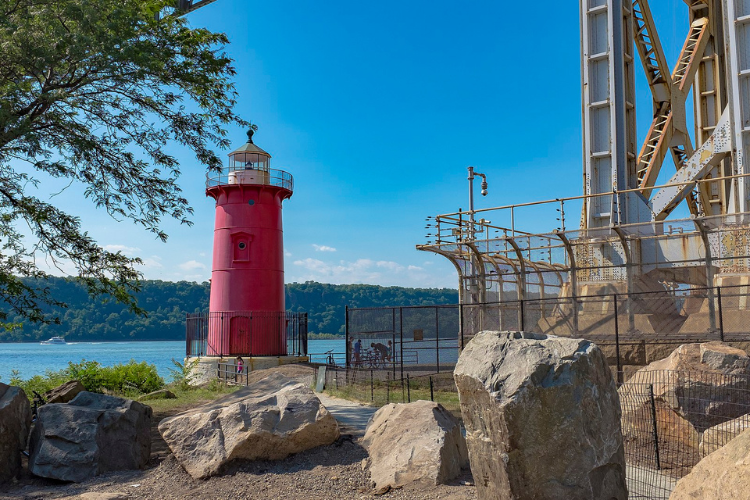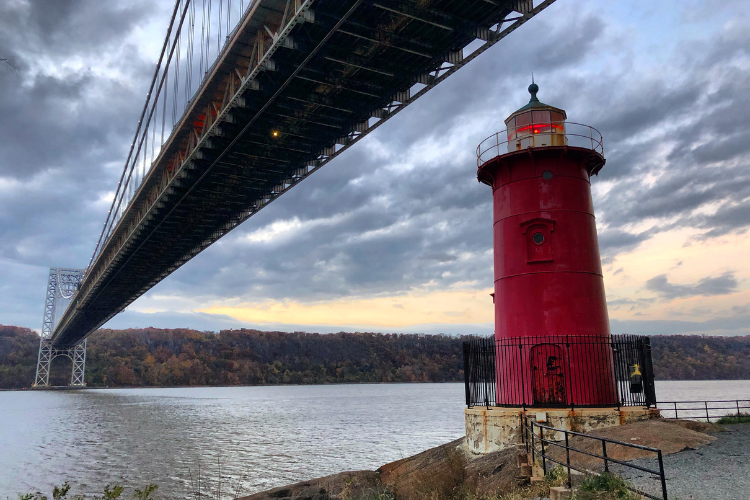5 Little-Known Facts About the Little Red Lighthouse in Washington Heights
On National Lighthouse Day, learn about the significance of this Uptown historical gem.

Tucked beneath the hustle and bustle of the world’s busiest vehicular bridge stands a fragment of New York City’s storied maritime history. Nestled just above the currents of the Hudson River and along the coastal outskirts of Fort Washington Park, the vibrant Little Red Lighthouse has become a fixture of Washington Heights’ landscape. Although it only stands 40 feet tall, the structure and its surrounding land are packed with past tales that shine a light on 19th century New York City.
As we mark National Lighthouse Day, which is observed annually on August 7, we’re diving into the significance behind one of the Big Apple’s last-standing lighthouses. Here are five things you should know about the Little Red Lighthouse.
Jeffrey’s Hook Waterfront: A Cautionary Tale
Although the lighthouse’s widely-known moniker is derived from its bright fire engine red exterior, its alternative name is Jeffrey's Hook Lighthouse. Parts of Upper Manhattan and Eastern, New Jersey are the ancestral lands of Lenape peoples and Washington Heights was inhabited by the Weckquaesgeek tribe. According to the New York City Parks Department, during the 17th century, the Weckquaesgeek, as well as Dutch and English colonists, used the Hudson River banks for fishing and hunting.
At this time, it was also evolving into a primary traveling route as a coastal gateway to the Atlantic Ocean. As the Hudson River emerged as a busier waterway, shipwrecks were common occurrences. To prevent accidents, a red pole was placed at Jeffrey’s Hook riverbank—and topped with two lanterns in 1889—for travelers to err on the side of caution.
It was originally constructed in Sandy Hook, New Jersey.
Built in 1880, the Little Red Lighthouse got its start in Sandy Hook, New Jersey. It was utilized as a guiding light for ships as they navigated choppy waters in and out of the New York harbor through the night. Nearly 47 years after it was created, it became defunct which ultimately led to its deconstruction. Four years after, it was resurrected and revitalized by the U.S. Coast Guard and placed along the Hudson River in Washington Heights—just years before the groundbreaking of the George Washington Bridge.
Under the Shadow of a Modern Marvel
After the George Washington Bridge, a modern marvel that ushered in a new era of transportation innovation, opened in 1931, the Little Red Lighthouse was left in the shadows of its towering gray steel structure. Since the lighthouse had fallen into disuse, the Coast Guard planned to auction off its fragments. It was once again decommissioned in 1948, though it remained on the waterfront as a non-operational lighthouse.

A Preservation Movement Propelled by a Children’s Book
Penned by authors Hildegarde Swift and Lynd Ward, the 1942 children’s book The Little Red Lighthouse and the Great Gray Bridge would become a literary cry for the preservation of Jeffrey's Hook Lighthouse. The book delved into the significance of the lighthouse and its place and purpose in an ever-changing world.
The Little Red Lighthouse and the Great Gray Bridge sparked a movement; motivating people from the local community and beyond to raise funds and write letters for its protection. In 1979, after being turned over to the New York City Department of Parks & Recreation, it landed a spot on the National Register of Historic Places—an initiative created to conserve spaces and structures throughout the country that are embedded in the fabric of American history. It’s said that its signature name the “Little Red Lighthouse” was inspired by the piece of literature.
It’s Manhattan’s Only Standing Lighthouse
According to the Historic House Trust Of NYC, the Little Red Lighthouse is Manhattan’s only standing lighthouse and one of the last-surviving lighthouse structures across the five boroughs. Its 143-year lifespan and legacy is evidence of its longevity and staying power amid rapid change. Although tours of the historical gem are rare and it isn't currently used for martime activities, if you ever get the chance to take a peek inside, you’ll be greeted by its 48 castiron plate spiraled steps, one of its original fixtures.